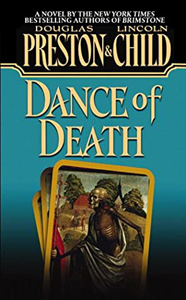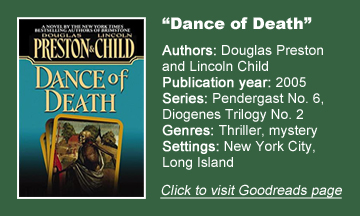It’s an odd phenomenon – which I’m sure many readers have experienced – where we remember earlier works from authors better than their more recent works. A benefit of this oddity of memory is that I got to experience Douglas Preston and Lincoln Child’s “Dance of Death” (2005) freshly, all over again.
In this second book of the Diogenes Trilogy, the gang is all here, as are many beloved locations from previous books. But this isn’t a flashback episodes or greatest hits compilation; the authors have new tales to tell with our old favorites.
Diogenes blossoms as a villain
Briefly glimpsed in “Brimstone,” Pendergast’s brother Diogenes blossoms as a villain here. He’s sort of like Thomas Harris’ Hannibal Lecter in that he’s a sociopath with great insight into other people’s minds, but P&C don’t treat him as a spice the way Harris treats Lecter in the early Hannibal books.
We experience Diogenes through the eyes of his kidnap victim, Viola Maskelene, whose mutual love-at-first-sight with Aloysius is portrayed in “Brimstone.”
While Aloysius is brilliant as always, so is Diogenes in this chess game in which the New York City area is the board. The agent can pull off amazing, innovative schemes, but he has to seemingly think harder when it comes to his brother; among his insights is that Diogenes’ hatred of him is Diogenes’ reason to live.
P&C pull off a tightrope trick wherein “Dance of Death” is loaded with information about this villain, yet the childhood incident that is the centerpiece for his hatred remains a mystery for a future book.
The gang’s all here
As noted, the gang’s all here, including characters who at first glance serve redundant roles. Margo is working at the museum, and so is Nora. Smithback is pursuing the hot stories in his New York Times job, and so is Harriman.
These pairings allow for rivalries, and also increase the possibility that they could really be killed off (as all of Pendergast’s friends and acquaintances are pawns in Diogenes’ game). For example, if one of the museum heroines is killed off, the other is still available for that role in future yarns.
In fact, the Margo-Nora rivalry is a surprisingly great part of “Dance of Death,” as we explore Margo’s ethical and career conundrum over printing an editorial in Museology criticizing her museum’s decision to hold on to Tano Indian masks rather than returning them to the tribe. The authors dig into both sides of the debate.
With Smithback, they have some comedic fun, as Pendergast sticks the reporter in a high-security nuthouse for his own safety and then Smithback tries to escape. I probably want to see Smithback as more heroic than the authors do, but I can’t deny these chapters are amusing.
The meta gag of Smithback bragging about his nonfiction accounts titled “Relic,” “Reliquary” and “Thunderhead” is a little on the nose, though. I was narrowing my eyes at P&C in that chapter, thinking “Really, guys?” But oh well, it’s all in good fun.

Clever timing trick
The authors also take advantage of the large cast of characters with a smart timing trick in alternating chapters: Two characters are being chased by someone who is seemingly Diogenes – which one is under the real threat, and which one is merely spooked?
In lesser hands, it would be lazy to return to the well of a character moving through a darkened museum exhibit the night before the big opening, hearing mysterious sounds. But I can never return to the New York Museum of Natural History too many times, and it’s impressive how it’s still scary even though the threat of “Relic’s” Museum Beast is long gone.
P&C also make good use of the NYC underground, visiting the Iron Clock, a track switching station that was perhaps a setting they wanted to use in “Reliquary” but didn’t get a chance to.
Another strong point of “Dance of Death” is the competence of the core cops and detectives. Granted, the FBI’s Coffey – introduced in “Relic” – is here to be both too unimaginative and too personal in his dislike of Pendergast.
But D’Agosta is very much Pendergast’s sidekick here, and police detective Laura Hayward (D’Agosta’s girlfriend as of the previous book) is smart enough to match the evidence with her friends’ assertions that Diogenes is a real, living person and reach intelligent conclusions.
Too often in frame-job stories, the state’s detectives have their minds made up and they overlook evidence and witness statements, and a reader is left to stew over the injustice. As super-intelligent as Diogenes (and Aloysius, in his countermoves) is, Hayward and one of her bosses are able to see the truth.
“Dance of Death” is thoroughly satisfying on its own, yet it also leaves the door wide open for the third part of the trilogy, “The Book of the Dead,” another P&C tome I’m looking forward to rediscovering.


